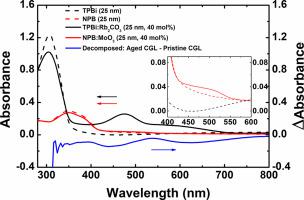Materials Today Energy ( IF 9.0 ) Pub Date : 2021-07-10 , DOI: 10.1016/j.mtener.2021.100794 A. Gasonoo 1 , Y.-J. Lim 2 , E.-J. Jang 1 , J. Lee 2 , M.-H. Kim 2 , Y. Choi 1 , J.-H. Lee 2

|
Investigation of the long-term stability of charge generation layers (CGLs) provides a fundamental and an essential approach in achieving highly efficient tandem organic electronic devices. Thus, in this foremost study, the degradation mechanism of electrically aged organic p-n heterojunction CGLs has been investigated by impedance and optical spectroscopy. Rubidium carbonate (Rb2CO3)–doped 2,2,2-(1,3,5-benzinetriyl)-tris(1-phenyl-1H-benzimidazole) (TPBi) and molybdenum trioxide (MoO3)–doped 1,4-bis[N-(1-naphthyl)-N′-phenylamino]-4,4′-diamine (NPB) are used as the n-type and p-type organic semiconductors, respectively. A detailed analysis from capacitance-frequency (C–F) and capacitance-voltage (C–V) characteristics reveals reduced charge generation and 19.6% reduction in the geometric capacitance of the CGL after electrical aging. Reduced peak intensity from UV–Vis–NIR spectra of the aged CGL points to 21.4% charge transfer complex decomposition of the Rb2CO3-doped TPBi. We propose that the rate-limiting step of charge generation in the CGL is caused by the electron transport in the TPBi:Rb2CO3 layer and not the charge generation itself at the TPBi:Rb2CO3/NPB:MoO3 heterojunction. This simple, comprehensive, and non-destructive technique facilitates a crucial analysis that underpins the mechanism of device degradation and further provides a fundamental approach in developing highly stable CGLs for efficient organic electronic devices.
中文翻译:

用阻抗和光谱法分析掺杂有机p -n异质结电荷产生层的降解
对电荷生成层 (CGL) 长期稳定性的研究为实现高效串联有机电子器件提供了一种基本且必不可少的方法。因此,在这项最重要的研究中,通过阻抗和光谱学研究了电老化有机pn异质结 CGL的降解机制。碳酸铷 (Rb 2 CO 3 )-掺杂的 2,2,2-(1,3,5-苄基三基)-三(1-苯基-1H-苯并咪唑) (TPBi) 和三氧化钼 (MoO 3 )-掺杂 1, 4-双[N-(1-萘基)-N'-苯基氨基]-4,4'-二胺(NPB)分别用作n型和p型有机半导体。从电容-频率 ( C–F) 和电容-电压 ( C-V ) 特性表明,电老化后 CGL 的电荷生成减少,几何电容减少 19.6%。老化 CGL 的 UV-Vis-NIR 光谱峰强度降低表明 Rb 2 CO 3掺杂的 TPBi 的电荷转移复合物分解为 21.4% 。我们提出 CGL 中电荷产生的限速步骤是由 TPBi:Rb 2 CO 3层中的电子传输引起的,而不是 TPBi:Rb 2 CO 3 /NPB:MoO 3处的电荷产生本身异质结。这种简单、全面和非破坏性的技术促进了支持器件退化机制的关键分析,并进一步为开发用于高效有机电子器件的高度稳定的 CGL 提供了基本方法。











































 京公网安备 11010802027423号
京公网安备 11010802027423号